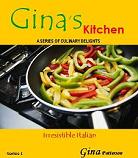|
order your copy today!
Home Recipes Food Facts Cooking Tips
Food
Facts
|
|
. |
|
|
Carrots have been consumed in many cultures for centuries. Cultivation began over a thousand years ago in the steppe regions of Central Asia. Originally, carrots were pretty much any colour except orange. It is an integral part of many Western cuisines today and it’s prized for its nutritional value. Carrots provide carbohydrates, protein, calcium, and iron. It is rich in fibre, potassium, biotin, thiamine, and Vitamins B1, B2, B6, C, and K. It provides the highest level of beta-carotene in vegetables commonly consumed. Beta-carotene provides protection against cancer development. Carrots are easily digested by most people and provide relief of constipation and other gastro-intestinal issues.
|
|
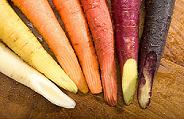 |
Carrots with Character - Carrots
are versatile vegetables and add colour to our dinner plates. Researchers
have selectively bred a rainbow of carrots - purple, red, yellow and
white.
|
|
Basil leaves contain many compounds that are known to have health promoting and disease preventing properties. In addition to high levels of beta-carotene, basil contains vitamins A and K. Basil is also an excellent source of iron.
|
 |
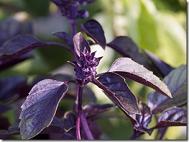 |
Purple basil is cultivated from ordinary basil and is used the same way as any green basil; for flavour or as a garnish. Purple basil is grown for their colour. Breeders sometimes will grow varieties that have the purple colour, but not the great basil flavour. Often times, the plant will go back to being green which can be avoided if the green shoots are removed when they appear. If the plant is left alone, it will eventually turn completely green.
|
|
Green asparagus is grown in a flat bed, exposed to sunlightwhich increases the chlorophyll content, which is what makes the asparagus green. The stalks are harvested when they are approximately 8 inches tall and 1/4 to 1/2 inch thick. Green asparagus has a more intense nutty flavor than the white or purple asparagus.
|
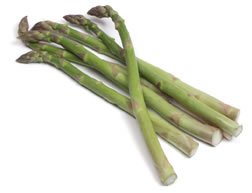
|
 |
White asparagus is grown underneath a mound of dirt whichkeeps the stalks from turning green. They are harvested once the stalks crack through the surface and early in the morning to limit exposure to the sun. White asparagus has a more delicate flavour than green or purple asparagus.
|
|
Purple asparagus
is grown in mounds similar to the white asparagus except it is allowed to grow approximately 3 inches above the surface before it is harvested, exposing it to the sunlight just enough to begin changing colours. When first exposed to the sun, asparagus Nutritional Value:
|
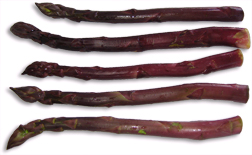 |
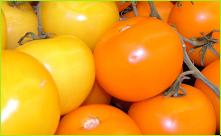 |
Most people believe that yellow, white and pink tomatoes are low in acidity. That's not the case. A lot of misinformation has been printed in the popular press about "low acid" tomatoes referring to those with a sweet, non-tart taste. The higher sugar content actually masks the acidic flavour.
|
|
Bananas are the number one fruit for the world’s athletes. Just two bananas provide enough energy for a strenuous ninety minute workout. Bananas are also known to help with dealing with various diseases and preventing others. Bananas are very low in sodium and high in potassium, ideal for blood pressure issues. Snacking on bananas helps keep the blood sugar up. This helps with avoiding morning sickness. Bananas can aid heartburn because it has a natural antacid component. Regular consumption of bananas has been linked to significantly cutting the risk of strokes. Because they are high in iron, bananas help produce haemoglobin production and helps with anaemia. Bananas contain tryptophan which the body uses to produce serotonin. Serotonin helps lift depressed moods and helps people relax.
|
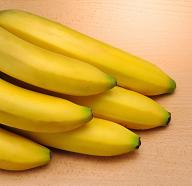 |
 |
Garlic provides true wealth in both its nutritional and medical value. Garlic has been used in food preparations for thousands of years. It has been used medically for just as long. Medical studies have shown that garlic can help with various heart issues. High cholesterol, blood clots, and high blood pressure can be alleviated with the consumption of garlic. Garlic has also been shown to help in preventing cancer and against some infections. What makes garlic so powerful? Garlic contains dozens of active compounds that have been shown to help in various ways. Garlic can be consumed naturally in food or with garlic capsules. Benefits aside, garlic just make foods taste fantastic. And what is a bit of garlic breath between friends?
|
|
Apples These marvels of nature deserve their reputation for keeping the doctor away when you eat one a day. And now, it seems, they can help you melt the fat away, too. First of all, they elevate your blood glucose (sugar) levels in a safe, gentle manner and keep them up longer than most foods. The practical effect of this is to leave you feeling satisfied longer, say researchers.Secondly, they’re one of the richest sources of soluble fiber in the supermarket. This type of fiber prevents hunger pangs by guarding against dangerous swings or drops in your blood sugar level, says Dr. James Anderson of the University of Kentucky’s School of Medicine. An average size apple provides only 81 calories and has no sodium, saturated fat or cholesterol. You’ll also get the added health benefits of lowering the level of cholesterol already in your blood as well as lowering your blood pressure.
|
 |
 |
Peppers Hot, spicy chili peppers fall into the same category as hot mustard says Dr. Jaya Henry of Oxford Polytechnic Institute in England. He studied them under the same circumstances as the mustard and they worked just as well. A mere three grams of chili peppers were added to a meal consisting of 766 total calories. The peppers’ metabolism-raising properties worked like a charm, leading to what Henry calls a diet-induced thermic effect. It doesn’t take much to create the effect. Most salsa recipes call for four to eight chilies – that’s not a lot. Peppers are astonishingly rich in vitamins A and C, abundant in calcium, phosphorus, iron and magnesium, high in fiber, free of fat, low in sodium and have just 24 calories per cup
|
|
Berries This is the perfect weight-loss food. Berries have natural fructose sugar that satisfies your longing for sweets and enough fiber so you absorb fewer calories that you eat. British researchers found that the high content of insoluble fiber in fruits, vegetables and whole grains reduces the absorption of calories from foods enough to promote weight loss without hampering nutrition. Berries are a great source of potassium that can assist you in blood pressure control. Blackberries have 74 calories per cup, blueberries 81, raspberries 60 and strawberries 45. So use your imagination and enjoy the berry of your choice.
|
 |
 |
Broccoli Broccoli is North America’s favourite vegetable, according to a recent poll. No wonder. A cup of cooked broccoli has a mere 44 calories. It delivers a staggering nutritional payload and is considered the number one cancer-fighting vegetable. It has no fat, loads of fiber, cancer fighting chemicals called indoles, carotene, 21 times the RDA of vitamin C and calcium. When you’re buying broccoli, pay attention to the colour. The tiny florets should be rich green and free of yellowing. Stems should be firm.
|
|
Melons Now, here’s great taste and great nutrition in a low-calorie package! One cup of cantaloupe balls has 62 calories, one cup of casaba balls has 44 calories, one cup of honeydew balls has 62 calories and one cup of watermelon balls has 49 calories. They have some of the highest fiber content of any food and are delicious. Throw in handsome quantities of vitamins A and C plus a whopping 547 mgs of potassium in that cup of cantaloupe, and you have a fat-burning health food beyond compare.
|
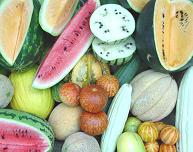 |
 |
Onions Flavourful, aromatic, inexpensive and low in calories, onions deserve a regular place in your diet. One cup of chopped raw onions has only 60 calories, and one raw medium onion (2.15” diameter) has just 42. They control cholesterol, thin the blood, protect against cholesterol and may have some value in counteracting allergic reactions. Most of all, onions taste good and they’re good for you. Partially boil, peel and bake, basting with olive oil and lemon juice. Or sauté them in white wine and basil, then spread over pizza. Or roast them in sherry and serve over pasta.
|
Custom
Google Search
